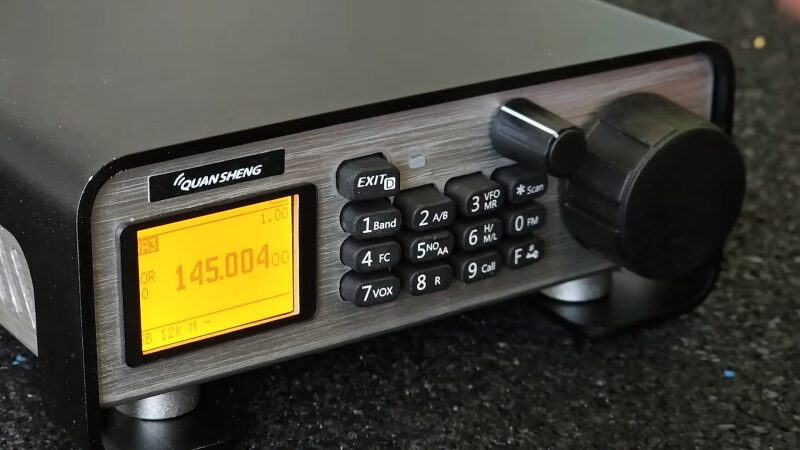

Today, we will see how OM0ET transforms the Quansheng walkie-talkie into a desktop machine. He uses ESP32 to create an encoder to control tuning tasks, integrating audio and data modules along with speakers into the case. In the video, he provides a detailed introduction on how to accomplish this task.
Transforming the Quansheng handheld device into a neat desktop transceiver
By: Lewin Day
The Quansheng UV-K5 is a popular handheld radio transceiver. It is ready to use out of the box but is also favored for its modification potential. OM0ET purchased one of these powerful VHF/UHF radio devices but wanted to use it as a desktop radio, thus he began the modification!
This may sound like a simple reinstallation, but it actually involves some extra work. Most notably, the design of the Quansheng walkie-talkie can only be tuned via the keyboard. However, using it on a desktop can be quite cumbersome. Therefore, to make communication easier, OM0ET decided to use ESP32 to create an encoder control device to handle tuning and other control tasks.This was achieved with the help of a person named OM0WT, and the relevant documentation has been placed on Github. Other tasks also included getting the keyboard to work in the new case and adjusting the audio and data modules along with the speaker to new positions.
Although the original handheld device is much smaller than the case currently in use, you would be surprised at how compact everything fits inside. However, the final result still looks good. We have seen other ham radio devices that are modifiable and upgradeable. Sometimes, customization is key!
Ham Radio Discussion:
Canuckfire says:
This looks like a Takachi case…
I have been looking at a lot of desktop hardware lately and have been very disappointed with most designs, and reinstalling some things honestly doesn’t seem like a practical project, but this has really inspired me!
S O says:
I’m not surprised, but I haven’t encountered a bad one myself. I see more and more people using them.
Lord Kimbote says:
Moreover, it and its many clones are very unreliable. The boss wanted to replace the old Motorola T200 keychain walkie-talkie with this one and bought a pack of about five units. It was a huge mistake. First, they could not recognize the programming cable that should have been standard equipment, nor could they recognize the software.
People always find ways to unlock them, messing up the settings.
I once thought about buying a real radio (Kenwood or Yaesu), but it just doesn’t seem worth it.
Tim says:
I once thought about adding a rotary encoder to my UV-K6 to replace the LED for up/down/select, which would greatly improve usability.
Andrew says:
I looked at the firmware of the controller in this project, and frankly, I was not impressed. Choosing such a processor for such a simple task is just bad.
To replace a pair of up/down buttons, you could use the Alps SRBM1L0800 rotary pulse switch:
https://www.aliexpress.com/item/1005007262397665.html
Unfortunately, it does not have a built-in button.
Conor Stewart says:
It works once, and it works, what more do you want?
It may not be the best, and it may not be the way you would do it.
Andrew says:
What more do I want? Something less convoluted.
For example, modifying the firmware in the radio so that the rotary encoder can be connected directly to the I/O pins of the switch and rewriting the firmware to accommodate it.
Why write about the pulse switch? So others can see an alternative method and use it if they wish. I believe you didn’t know before, and now you do.
Both ideas imply that no additional mini device is needed, meaning the space inside the box won’t be so cramped.
CJay says:
Clearly, you are free to create your own “elegant” solutions.
I guess you would also criticize my modification of the old 8Ch Icom PMR radio because I added a processor module and OLED to the rotary encoder to provide memory, duplex, CTCSS, and 200Ch functions instead of figuring out how to unlock the original OTP processor and reprogram it…
Joshua says:
I completely understand you. If something is done poorly, it frustrates me too.
Sometimes I even can’t sleep because it bothers me so much.
Then I sit up in bed and jot down a few notes on how to improve things.
This helps me to fall back asleep. The problem may not be solved, but I feel at ease.
Tinker says:
This build process has many great ideas and techniques. I have been soldering wires to flexible connectors and then to the circuit board. I did not think about securing a sub-board locally and wiring on that sub-board. This technique seems more stable. While I might have chosen some different components based on what I had on hand, the overall build quality is quite reliable. The reuse of existing items is also commendable.
Kapitano says:
I would love to see a high-frequency version of a desktop with a rotary encoder.
Lolek says:
I need a built-in audio modem or built-in Raspberry Pi interface for packet radio, reticulum, M17, APRS, and others.
Joshua says:
Indeed. Serious packet radio operations (9K6 baud FSK) require FM demodulator output.
Even 1200 and 2400 baud AFSK sounds bad through the headphone output.
Direct AF input bypassing the microphone amplifier is also nice.
For example, CTCSS tones below 100 Hz will be suppressed by the microphone amplifier.
(The same low-frequency suppression or filter curve may also make the 1200 Hz tone of packet radio sound weaker than the 2200 Hz tone).
By the way, that’s why CTCSS is difficult to retrofit on traditional radio equipment in Europe/Germany.
If you want to know, we traditionally use a 1750 Hz tone to open FM repeaters.
CTCSS is an American thing, and some of us simply don’t want to accept it.
Many of us still don’t want to learn. So our walkie-talkies lacked this feature for a long time.
Until the 2000s, more and more FM repeaters started using CTCSS (sadly!), making classic walkie-talkies unusable on FM repeaters (some repeaters use carrier detection instead of CTCSS).
Paul Brooks says:
Wow, I would love to make something like this, is there a chance to get one? Paul M1AFQ
source: hackaday.com






